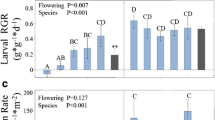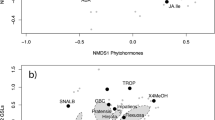Abstract
We experimentally reanalyzed the classic interaction between Pieris rapae, a specialist lepidopteran herbivore, and isothiocyanates (mustard oils) that are characteristic phytochemicals of the Brassicaceae. Previous investigations have suggested that P. rapae is unaffected by isothiocyanates. Using whole plants, root extracts, and a microencapsulated formulation of allyl isothiocyanate, we now show that isothiocyanates reduce herbivore survival and growth, and increase development time, each in a dose-dependent manner. Neither the substrate allyl glucosinolate, nor myrosinase, the enzyme that results in the breakdown of glucosinolates, negatively affected P. rapae. Thus, we present strong evidence for a role for isothiocyanates in plant resistance against the specialist herbivore P. rapae.
Similar content being viewed by others
References
Adler, L. S., Schmitt, J., and Bowers, M. D. 1995. Genetic variation in defensive chemistry in Plantago lanceolata (Plantaginaceae) and its effect on the specialist herbivore Junonia coenia (Nymphalidae). Oecologia 101:75–85.
Agelopoulos, N. G., Dicke, M., and Posthumus, M. A. 1995. Role of volatile infochemicals emitted by feces of larvae in host-searching behavior of parasitoid Cotesia rubecula (Hymenoptera: Braconidae): A behavioral and chemical study. J. Chem. Ecol. 21:1789–1811.
Agrawal, A. A. 1998. Induced responses to herbivory and increased plant performance. Science 279:1201–1202.
Agrawal, A. A. 2000a. Host range evolution: Adaptation of mites and trade-offs in fitness on alternate hosts. Ecology 81:500–508.
Agrawal, A. A. 2000b. Specificity of induced resistance in wild radish: Causes and consequences for two specialist and two generalist caterpillars. Oikos 89:493–500.
Agrawal, A. A. 2001. Phenotypic plasticity in the interactions and evolution of species. Science 294:321–326.
AGrawal, A. A., Laforsch, C., and Tollrian, R. 1999a. Transgenerational induction of defenses in animals and plants. Nature 401:60–63.
Agrawal, A. A., Strauss, S. Y., and Stout, M. J. 1999b. Costs of induced responses and tolerance to herbivory in male and female fitness components of wild radish. Evolution 53:1093–1104.
Bartlet, E., Kiddle, G., Williams, I., and Wallsgrove, R. 1999. Wound-induced increases in the glucosinolate content of oilseed rape and their effect on subsequent herbivory by a crucifer specialist. Entomol. Exp. Appl. 91:163–167.
Berenbaum, M. R. and Zangerl, A. R. 1998. Chemical phenotype matching between a plant and its insect herbivore. Proc. Nat. Acad. of Sci. USA 95:13743–13748.
Berenbaum, M. R., Zangerl, A. R., and Lee, K. 1989. Chemical barriers to adaptation by a specialist herbivore. Oecologia 80:501–506.
Blau, P. A., Feeny, P., Contardo, L., and Robson, D. S. 1978. Allylglucosinolate and herbivorous caterpillars: A contrast in toxicity and tolerance. Science 200:1296–1298.
Bodnaryk, R. P. 1992. Effects of wounding on glucosinolates in the cotyledons of oilseed rape and mustard. Phytochemistry 31:2671–2677.
Bones, A. M., Visvalingam, S., and Thangstad, O. P. 1994. Sulfate can induce differential expression of thioglucoside glucohydrolases (Myrosinases). Planta 193:558–566.
Bowers, M. D. 1991. Iridoid glycosides, pp. 297-325, in G. A. Rosenthal and M. R. Berenbaum (Eds.). Herbivores: Their Interactions With Secondary Plant Metabolites, Vol. I: The Chemical Participants 2nd edn. Academic Press, San Diego, California
Broadway, R. M. 1995. Are insects resistant to plant proteinase inhibitors? J. Insect Physiol. 41:107-116
Brown, P. and Morra, M. 1995. Glucosinolate-containing plant tissuesas bioherbicides. J. Agric. Food Chem. 43:3070–3074.
Chew, F. S. 1988. Searching for defensive chemistry in the Cruciferae, do glucosinolates always control interactions of Cruciferae with their potential herbivores and symbionts? No!, pp. 81-112, in K. C. Spencer (ed.). Chemical Mediation of Coevolution. Academic Press, San Diego, California
Dawkins, H. C. 1981. The misuse of t-tests, LSD and multiple range tests. Bull. Br. Ecol. Soc. 12:112–115.
Dawkins, H. C. 1983. Multiple comparisons misused — Why so frequently in response-curve studies. Biometrics 39:789–790.
Dyer, L. A. 1995. Tasty generalists and nasty specialists—Antipredator mechanisms in tropical lepidopteran larvae. Ecology 76:1483–1496.
Engler, H. S., Spencer, K. C., and Gilbert, L. E. 2000. Insect metabolism — Preventing cyanide release from leaves. Nature 406:144–145.
Faulkner, K., Mithen, R., and Williamson, G. 1998. Selective increase of the potential anticarcinogen 4-methylsulphinylbutyl glucosinolate in broccoli. Carcinogenesis 19:605–609.
Feeny, P. P. 1976. Plant apparency and chemical defense, pp. 1-40, in J. W. Wallace and R. L. Mansell (Eds.). Biochemical Interaction Between Plants and Insects. Plenum, New York
Futuyma, D. J. and Moreno, G. 1988. The evolution of ecological specialization. Annu. Rev. Ecol. System. 19:207–234.
Giamoustaris, A. and Mithen, R. 1995. The effect of modifying the glucosinolate content of leaves of oilseed rape (Brassica napus ssp. oleifera) on its interaction with specialist and generalist pests. Ann. Appl. Biol. 126:347–363.
Kliebenstein, D., Pedersen, D., Barker, B., and Mitchell-olds, T. 2002. Comparative analysis of quantitative trait loci controlling glucosinolates, myrosinase and insect resistance in Arabidapsis thaliana. Genetics 161:325–332.
Krieger, R. I., Feeny, P. P., and Wilkinson, C. F. 1971. Detoxication enzymes in the guts of caterpillars: An evolutionary answer to plant defenses? Science 172:579-580
Li, Q., Eigenbrode, S. D., Stringham, G. R., and Thiagarajah, M. R. 2000. Feeding and growth of Plutella xylostella and Spodoptera eridania on Brassica juncea with varying glucosinolate concentrations and myrosinase activities. J. Chem. Ecol. 26:2401–2419.
Linhart, Y. B. 1991. Disease, parasitism and herbivory: Multidimentional challenges in plant evolution. Trends Ecol. Evol. 6:392–396.
Louda, S. and Mole, S. 1991. Glucosinolates: Chemistry and ecology, pp. 123-164, in G. A. Rosenthal and M. R. Berenbaum (Eds.). Herbivores: Their Interactions With Secondary Plant Metabolites, Vol. I: The Chemical Participants 2nd edn. Academic Press, San Diego, California
Malcolm, S. B. and Zalucki, M. P. 1996. Milkweed latex and cardenolide induction may resolve the lethal plant defence paradox. Entomol. Exp. Appl. 80:193–196.
McCloskey, C. and Isman, M. B. 1993. Influence of foliar glucosinolates in oilseed rape and mustard on feeding and growth of the bertha armyworm Mamestra configurata Walker. J. Chem. Ecol. 19:249–266.
Ohsaki, N. and Sato, Y. 1994. Food plant choice of pieris butterflies as a trade-off between parasitoid avoidance and quality of plants. Ecology 75:59–68.
Ratzka, A., Vogel, H., Kliebenstein, D. J., Mitchell-olds, T., and Kroymann, J. 2002. Disarming the mustard oil bomb. Proc. Nat. Acad. Sci. USA 99:11223–11228.
Renwick, J. A. A. 2001. Variable diets and changing taste in plant–insect relationships. J. Chem. Ecol. 27:1063–1076.
Renwick, J. A. A. and Lopez, K. 1999. Experience-based food consumption by larvae of Pieris rapae: Addiction to glucosinolates? Ent. Exp. Appl. 91:51-58
Rhoades, D. F. 1979. Evolution of plant chemical defense against herbivores, pp. 3-54, in G. A. Rosenthal and D. H. Janzen (Eds.). Herbivores: Their interation With Secondary Plant Metabolites. Academic Press, New York
Schoonhoven, L., Jermy, T., and Van Loon, J. 1998. Insect–Plant Biology. Chapman and Hall, London
Siemens, D. H. and Mitchell-Olds, T. 1998. Evolution of pest-induced defenses in Brassica plants: Tests of theory. Ecology 79:632–646.
Slansky, F. and Feeny, P. 1977. Stabilization of rate of nitrogen accumulation by larvae of cabbage butterfly on wild and cultivated food plants. Ecol. Monogr. 47:209–228.
Stowe, K. A. 1998. Realized defense of artificially selected lines of Brassica rapa: Effects of quantitative genetic variation in foliar glucosinolate concentration. Environ. Entomol. 27:1166–1174.
Szente, L., Magisztrak, H., and Szejtli, J. 1990. Formulation of insect controlling agents with beta-cyclodextrin. Pest. Sci. 28:7–16.
Thompson, J. N. and Cunningham, B. M. 2002. Geographic structure and dynamics of coevolutionary selection. Nature 417:735–738.
Traw, M. B. and Dawson, T. E. 2002. Reduced performance of two specialist herbivores (Lepidoptera: Pieridae, Coleoptera: Chrysomelidae) on new leaves of damaged black mustard plants. Environmen. Entomol. 31:714–722.
Usher, B. F., Bernays, E. A., Barbehenn, R. V., and Wrubel, R. P. 1989. Oral dosing of insects with feeding deterrent compounds. Entomol. Exp. Appl. 52:119–133.
Van Dam, N. M., Hadwich, K., and Baldwin, I. T. 2000. Induced responses in Nicotiana attenuata affect behavior and growth of the specialist herbivore Manduca sexta. Oecologia 122:371–379.
Van Dam, N. M., Van Der Meijden, E., and Verpoorte, R. 1993. Induced responses in three alkaloid-containing plant species. Oecologia 95:425–430.
Van Der Meijden, E. 1996. Plant defence, an evolutionary dilemma: Contrasting effects of (specialist and generalist) herbivores and natural enemies. Entomol. Exp. Appl. 80:307–310.
Verschaffelt, E. 1910. The cause determining the selection of food in some herbivorous insects. Proc. K. Ned. Akad. Wet. 13:536–542.
Webb, S. and Shelton, A. 1988. Laboratory rearing of the imported cabbageworm, pp. 1-6, in New York's Food and Life Sciences Bulletin No. 122. NY State Agric. Exp. St., Geneva, New York
Whittaker, R. H. and Feeny, P. P. 1971. Allelochemics: Chemical interactions between species. Science 171:757–770.
Yu, E. Y., Pickering, I. J., George, G. N., and Prince, R. C. 2001. In situ observation of the generation of isothiocyanates from sinigrin in horseradish and wasabi. Biochim. Biophy. Acta 1527:156–160.
Author information
Authors and Affiliations
Corresponding author
Rights and permissions
About this article
Cite this article
Agrawal, A.A., Kurashige, N.S. A Role for Isothiocyanates in Plant Resistance Against the Specialist Herbivore Pieris rapae . J Chem Ecol 29, 1403–1415 (2003). https://doi.org/10.1023/A:1024265420375
Issue Date:
DOI: https://doi.org/10.1023/A:1024265420375




